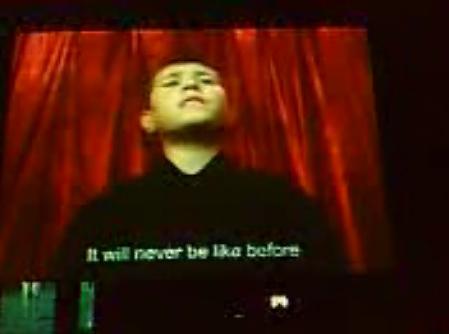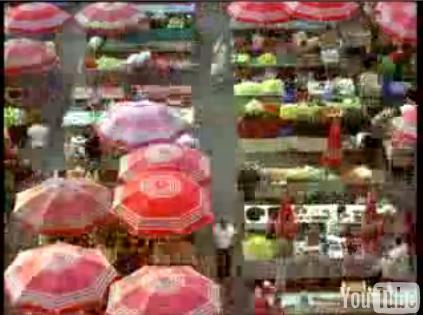REVOLUTION IS THE RESOLUTION
A couple of months ago, I had my eMule++ running, the slowest but the most comprehensive p2p client, and found Marina Abramovi?\'s most recent video, »Balkan Erotic Epic« (2006), available in high-quality, non-preview resolution.1 It was remarkable, since the video had just been produced, as opposed to those that surface in collections of almost forgotten works pre-dating video art (e.g. in the Ubuweb digital film collection), or those that became public through peculiar streaming sessions back in the days of Internet experimentation.2
It is not easy to get a work from a gallery that satisfies whatever »artistic level« is desired or fulfills strict technical demands. In fact, even importing and exporting or settling screening royalties is a complicated issue – although admittedly less complicated, for example, than importing a sculpture. This is one reason why video festivals are the most international events today, and the cheapest way to get plenty of artworks is to announce a video competition. But what can one do with the downloaded work? It is, of course, illegal due to its source, though even the most restrictive copyright laws have a »loophole« allowing non-commercial use under the designation »for educational purposes only.«3
Video Art Piracy
Teaching video art history is actually quite difficult since reviews seldom provide more than technical information on the artworks, tying them into a fictitious historical narrative without really demonstrating or illustrating anything. Videos by their very nature can hardly be represented by written descriptions, whether or not these are accompanied by video stills, which usually serve only to decorate the text. Video art is mostly indexed using systems of representation inherited from other art forms, such as the traditional exhibition catalogue, giving rise to a black hole of understanding since it cannot be captured in photographs like static art such as sculptures and paintings. As a consequence, art historians have shown little interest in tracing the technical line of development in video art, a gap that has become all the more apparent with today\'s explosion of various video formats, festivals and artists. Namely, while one historical line of media development can be seen in experimental film, the other, more content-related, is told through the history of art experiments.4
An even larger paradox in the representation of video art, one under which video archives themselves suffer, is the time factor. If an archive is good, the works are protected from viewing; if it is bad, it is possible to see the artworks, but they\'re usually not in the best condition for viewing. So, rather than making informative visits, generation after generation, to video art archives, for example the ZKM (Center for Art and Media Karlsruhe), academics collect illegal videos, often projecting them in better quality than can be achieved with an archive\'s preview copy. Some archives do provide online video previews, but in such poor quality that one may ask whether they are even worthy of the artwork.5
Videos end up being collected as preview thumbnails with pixilated surfaces. There simply has to be some way to collect them for educational purposes. Still, what seems less unfair about the »theft« of originals is the fact that downloaded copies can be shown at higher resolutions than the legal preview versions. Beyond this, the copies do not pressure the viewer, as at festivals, and do not set requirements with respect to the place of viewing.
Video Prostitution, €50 per Minute?
Aside from archives, videos are also gathered in special distribution centers. The difference between acquiring a video from a distribution center or festival and taking the matter into one\'s own hand lies in the screening fee, which can be 50 times the length of the video in minutes. Since such contracts are a capitalist invention, artists from other countries cannot track whether an artwork has been stolen and screened elsewhere.
Moreover, a certain naiveté underlies the exchange of videos between former Socialist countries where the copy has a privileged position over the original. Other countries, such as many in Central and South America, are eager to exchange works with Europe, so it is quite easy to acquire award-winning films from VideoBrazil for free, but not from more peripheral EU festivals. Problems arise as soon as a programmer in a country that does not recognize screening royalties chooses a video from an EU country for inclusion in an international selection. Thus, for the most part, only Western artists succeed in realizing earnings in the colonized space of a Third-World video session. Furthermore, only EU curators and festival selection committees, for example, can show Eastern European video collections abroad. This is where paranoia begins to spread: who is making money on easily transferable video art from Third-World countries, including post-Communist ones, without the knowledge of the artists?
Salon Activism and Pop-Up Art
The question of free distribution sometimes originates with the artwork itself. Some authors sign contracts for »elite« numbered copies in order to control the distribution themselves: for example, Kristina Leko, whose video »Milk 2002-2003« had activist content involving the rescue of milkmaids. Others, such as Ana Hušman, are committed to and work with the Creative Commons label, for a totally different reason.6 The »elite copy« is not really connected with a specific topic, but rather with the question of who invested in the original production of the piece. If artworks are funded by national authorities or NGOs, claims Hušman, they should not be used for commercial, but rather for educational purposes.
DivX and AVI
Still, the case of Abramovi? confirms a situation where, today, no one is protected, even with smaller digital online preview resolution or a distribution center. Once a copy of a work exists, it is no longer possible to control its proliferation. DivX and AVI formats are everywhere. Video art has found its way into private collections of MTV spots, pornos, weird cartoons and movies, mixing in with their content. In such company, even Abramovi?’s work seems to lose its original theme of autobiographical myth formation, getting mixed up with recorded performances of the Croatian band LET 3, various pornos and animated films, etc., while on the other hand finding itself facing the challenge of feature film productions as well as humble home videos.
It seems that not only video formats are changing, but that a new »cultural codex« is needed. Some propagate free exchange, while others demand legally proper royalties. Annoying pixels are gladly overseen in the hunger for information and the eroticism of the theft. Before the appearance of collection centers and distribution contracts, copies were often illegally distributed, but not on the scale seen today and at a tempo that is nearly synchronous with the actual production rate.
1 For example: ed2k://|file|Destricted%20-%20Balkan%20Erotic%20Epic%20-2006-%20Caspar%20Noe-Abramovic%20CD2.avi|700348416|1942D0CE7FCD9B04292F1F401E5D4AF7|/
The same video in .avi format is available in three sizes: 667.90 MB, 96.40 MB and 76.92 MB and with slightly different names, resolution variable.
2 Until www. ubuweb.com appeared, there were several attempts to make video sessions from museums using streaming. These collapsed because all the user had to do to collect the whole session was to manually restart the computer.
3 May also be viewed at Ubuweb
4 For example, early Modernist experimental films.
5 Real Player broadcasts of Video Data Bank http://www.vdb.org/ or Contemporary Video Art from the museums in Cologne http://www.museenkoeln.de are hardly fair to the original artworks, though they are still more informative than exhibition catalogues.
6 Kristina Leko’s Milkmaids communication project is available in 3 copies. http://www.cityofwomen-a.si/2003/artists/eng/Leko.html
Ana Hušman\'s award-winning video Plac (video, PAL, 16mm on digitBETU, 09:32, 2006) is available in a small-size preview in Macromedia Flash at http://www.anahusman.net/video/plac/ and also on DVD distributed by Egoboo.Beats

